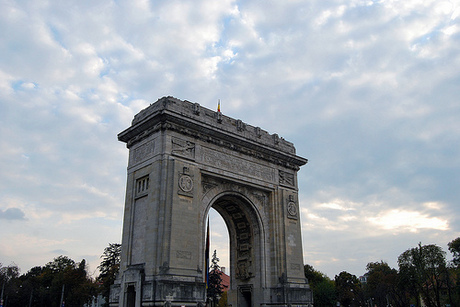The Arch of Triumph
You will most probably pass the Arc de Triumph on your way from the airport to the city. It has a massive Romanian flag attached. Looks identical to the Arc in Paris. This Arch was erected in memory of those killed during WW I. Arc de Triumph is located in the north of Bucharest, sector 1, the road intersection with boulevards Constantin Prezan, Sos.Kiseleff, Bd. Maresal Averescu and the Str. Alexandru Constantinescu.
Arcul de Triumf is a triumphal arch located in the northern part of Bucharest, on the Kiseleff Road. The first, wooden, triumphal arch was built hurriedly, after Romania gained its independence (1878), so that the victorious troops could march under it. Another temporary arch was built on the same site, in 1922, after World War I, which was demolished in 1935 to make way for the current triumphal arch, which was inaugurated in September 1936.
The current arch has a height of 27 meters and was built after the plans of the architect Petre Antonescu. It has as its foundation a 25 x 11.50 meters rectangle. The sculptures with which the facades are decorated were created by famous Romanian sculptors such as Ion Jalea and Dimitrie Paciurea. Nowadays, military parades are held beneath the arch each 1 december, with the occasion of Romania's national day.
Initially built of wood in 1922 to honor the bravery of Romanian soldiers who fought in World War I, Bucharest's very own Arc de Triomphe was finished in Deva granite in 1936. Designed by the architect, Petre Antonescu, the Arc stands 85 feet high. An interior staircase allows visitors to climb to the top for a panoramic view of the city. The sculptures decorating the structure were created by leading Romanian artists, including Ion Jalea, Constantin Medrea and Constantin Baraschi.
It is situated at the second circus of the Kiseleff boulevard, at its intersection with Marshal Prezan and Marshal Averescu Boulevards, near one of the south entries of the Herastrau Park.
The first monument, a wooden one, was erected on the same spot in 1922. The actual arch was built in 1935 in Deva granite, by Architect Petre Antonescu, who is also the father of the Bucharest City Hall. It is conceived in classical style, following the model of the great Arch of Triumph in Paris.
Its shape is that of a parallelipiped, with a 25 x 11.5 m basis and a height of 27 m. Its span is 11 m high and 9.5 m wide and has an arch of a circle at its upper part. The two feet of the monument have interior staircases which lead to the terrace of the monument.
Its façades are decorated with stone carvings -bas-reliefs, medallions, royal crowns and the effigies of Queen Mary and King Ferdinand, who had an important contribution to the 1918 union of all Romanian speaking provinces. Famous sculptors like Ion Jalea, Cornel Medrea, Mac Constantinescu, Frederick Storck, Dimitrie Paciurea or Constantin Baraschi contributed to the decoration of the monument.



